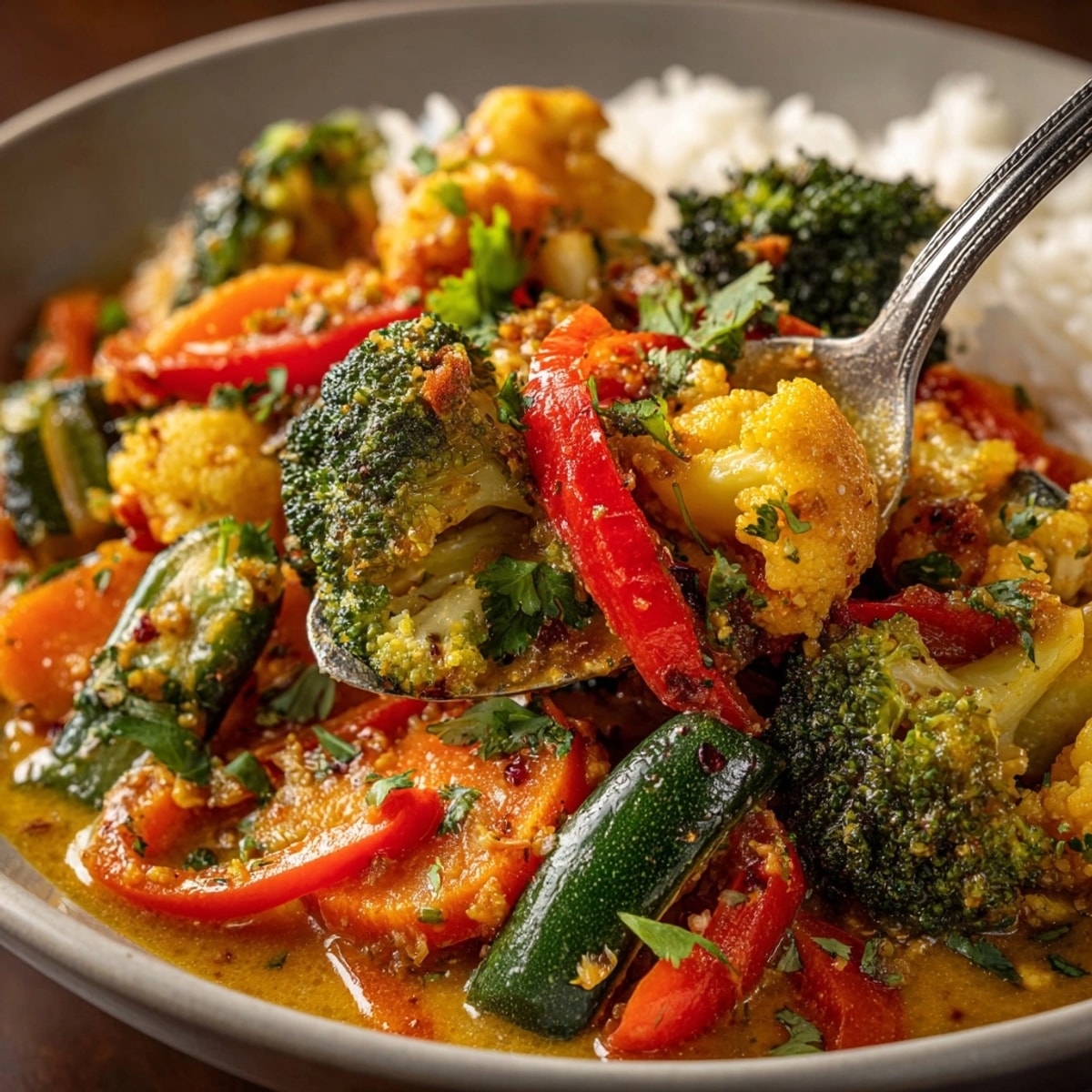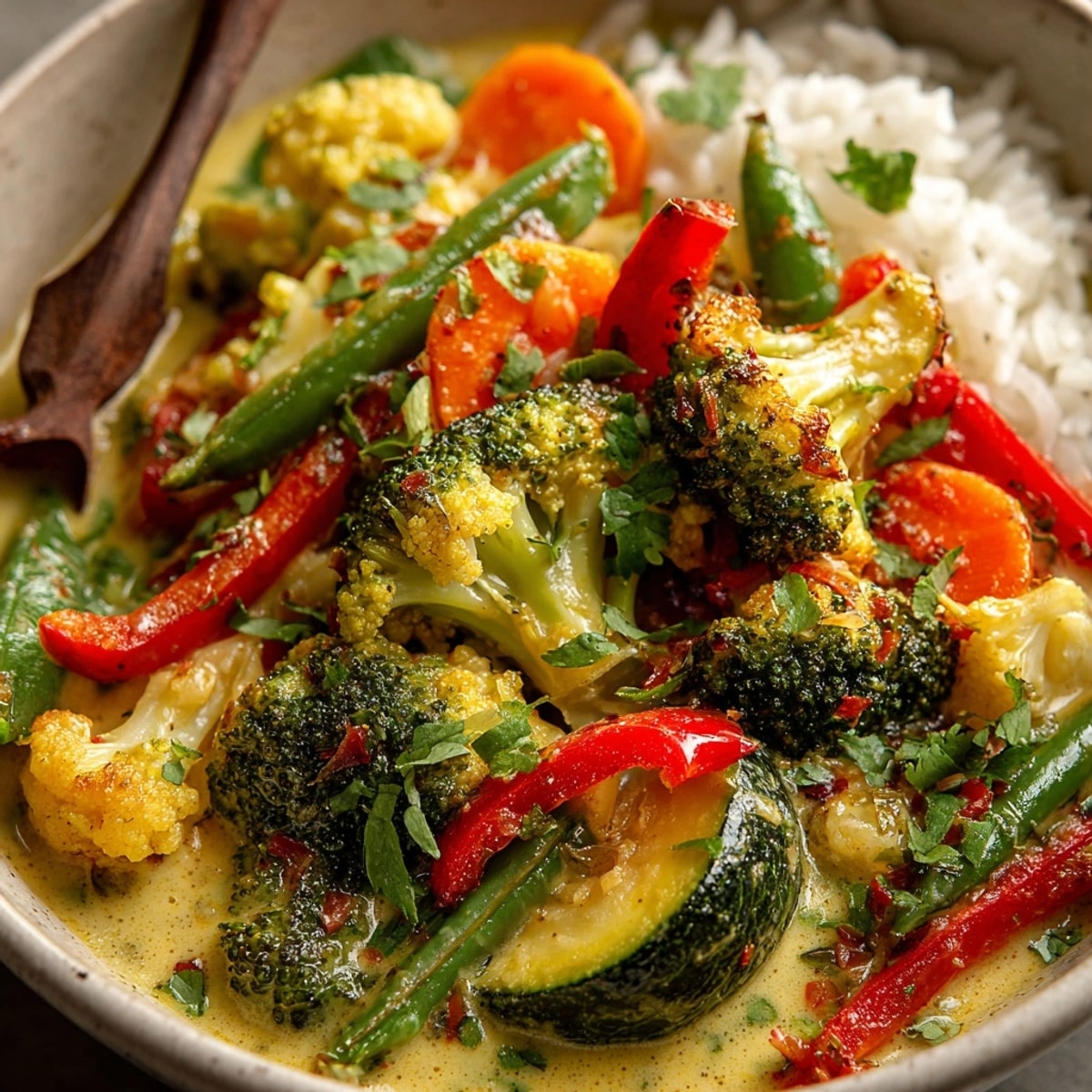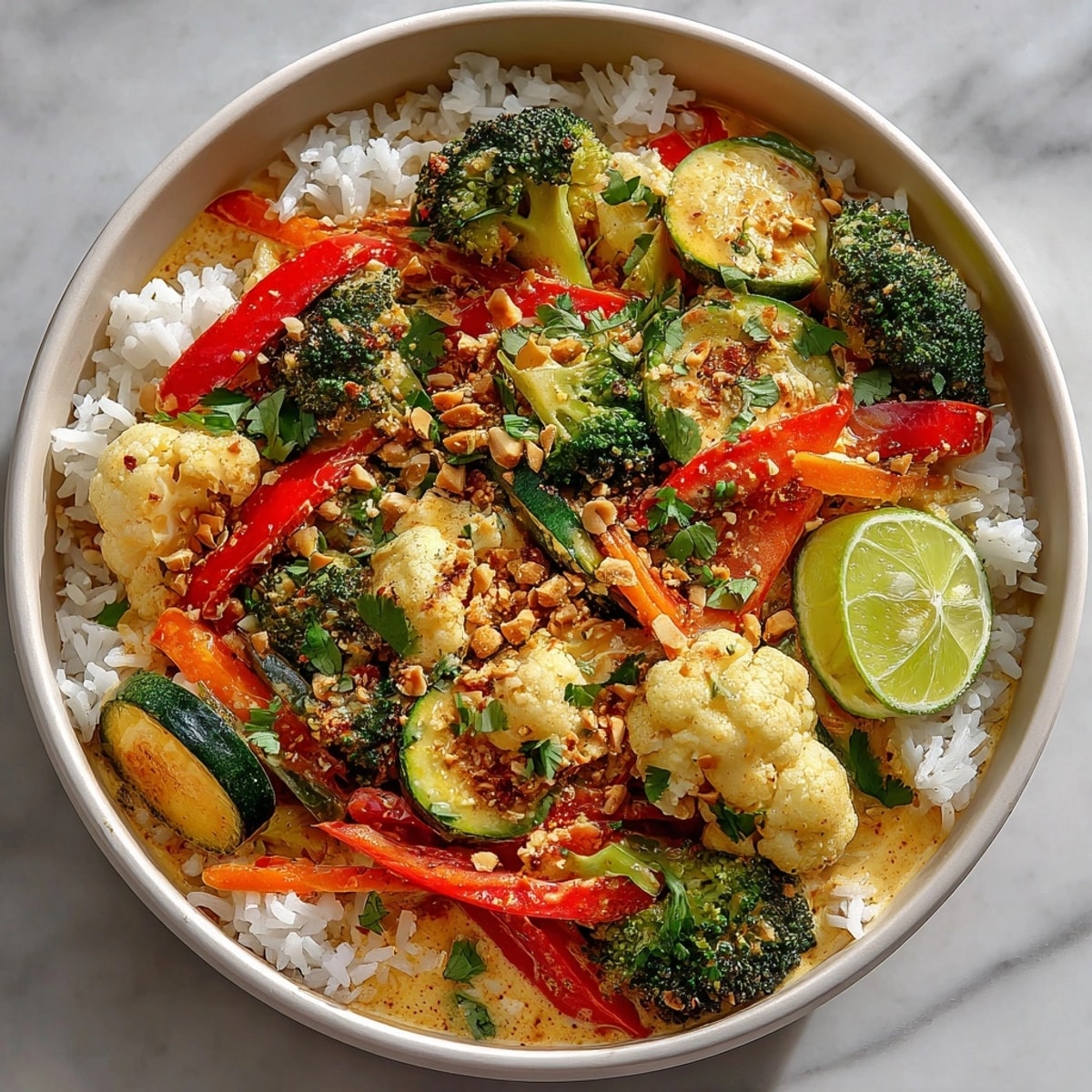 Save
Save This Thai Curry Vegetable Bowl is my answer for those days when I am craving something both comforting and vibrant. It brings together crisp-tender vegetables bathed in a luscious coconut curry sauce all spooned over fluffy jasmine rice for a meal that feels like a warm hug with every bite. Whether you are new to Thai cooking or love adding more veggies to your table this recipe brings the wow factor with very little fuss.
The first time I threw together a curry bowl like this was on a rainy Tuesday with a nearly empty fridge. I was amazed at how a handful of vegetables and a jar of curry paste transformed dinner into something everyone raved about for days.
Ingredients
- Broccoli florets: provide crunch and soak up curry flavor perfectly. Look for firm vibrant green crowns without yellowing
- Cauliflower florets: add hearty texture and make the bowl extra filling. Choose blemish free heads
- Red bell pepper: brings sweet contrast and color. Go for bright shiny peppers without soft spots
- Carrots: sliced thin for gentle sweetness and color. Pick carrots that are smooth and deep orange
- Snap peas: deliver a pop of green and a satisfying bite. Fresh crisp pods are best
- Zucchini: sliced for a touch of garden flavor and fast cooking. Choose small to medium and firm
- Coconut oil: infuses a subtle tropical richness. Use unrefined for the best aroma
- Onion: builds the flavor base. A regular yellow onion works great select one with tight skin and no sprouting
- Garlic: minced fresh for a savory backbone. Pick plump unblemished cloves
- Fresh ginger: grated for zing and warmth. Use knobby pieces with smooth taut skin
- Thai red curry paste: creates the essential aromatic base. Check ingredients for dietary needs and try brands like Maesri or Thai Kitchen
- Coconut milk: gives body and velvety texture. Choose full fat canned for creaminess
- Vegetable broth: stretches the sauce and helps vegetables simmer evenly. A low sodium option lets you control seasoning
- Soy sauce or tamari: deepens savory notes. For gluten free swap tamari
- Maple syrup or brown sugar: for rounding out the curry’s punchy heat. Pure maple syrup adds subtle complexity
- Juice of one lime: brightens the dish and balances the richness. Use fresh for zest and acidity
- Jasmine rice: fluffy fragrant and perfect for soaking up curry. Rinse well before cooking for best texture
- Fresh cilantro: chopped for sprinkling over the top. Pick leaves with strong color and no drooping
- Lime wedges: for adding at the table. Freshness really makes each bite pop
- Crushed peanuts: optional for crunch and a classic Thai topper. Roast lightly for best flavor
Instructions
- Prepare the Aromatics:
- Begin by heating coconut oil in a large skillet or wok over medium heat. Add finely chopped onion and let it cook gently for about three minutes. This slow sauté draws out sweetness and ensures there is no raw taste left
- Build Flavor:
- Add minced garlic and grated ginger stirring constantly for one minute. These give the sauce backbone and infuse the oil with complexity. Be careful not to let the garlic brown
- Toast the Curry Paste:
- Add in your Thai red curry paste and stir to coat the aromatics. Allow it to sizzle and release its essential oils for one to two minutes. You want the kitchen to fill with that unmistakable curry aroma as the paste cooks
- Simmer the Sauce:
- Pour in the coconut milk and vegetable broth using your wooden spoon to combine and scrape the bottom of the pan. Add soy sauce or tamari along with maple syrup or brown sugar. Increase the heat just enough to bring everything to a gentle simmer and meld the flavors
- Vegetable Stage One:
- Stir in the broccoli cauliflower carrots and bell pepper. Cover the skillet to trap steam which helps them cook evenly and soak in the curry flavors. Let these simmer undisturbed for seven to eight minutes until just starting to soften
- Vegetable Stage Two:
- Add in the snap peas and zucchini. These delicate vegetables go in later to stay vibrant and crisp tender. Leave the lid off and let them cook for another five to six minutes so everything is cooked but not bland
- Final Seasoning:
- Squeeze in fresh lime juice and stir well. Taste and adjust seasoning if needed more soy for saltiness more maple for sweetness or a tad more lime for brightness
- Serving Up:
- Scoop steaming jasmine rice into bowls then ladle the curried vegetables and sauce over top. Finish with chopped cilantro extra lime wedges and peanuts for crunch if you like
 Save
Save I am always happiest when fresh cilantro goes on top because it reminds me of family dinners when everyone passes around the bowl for a handful of herbs. Lime juice to finish makes every spoonful taste like sun and tropical breezes even in the dead of winter
Storage Tips
Leftover Thai curry keeps beautifully in the fridge for up to four days. Store the rice and curry separately to keep textures just right. Warm the curry gently on the stove with a splash of broth to freshen it up and don’t forget to add a squeeze of lime before enjoying again
Ingredient Substitutions
You can swap in almost any quick cooking vegetable such as green beans sweet potato kale or baby corn. If you need to avoid soy simply use coconut aminos in place of tamari and if you cannot do tree nuts skip the peanuts or choose toasted pumpkin seeds
Serving Suggestions
Serve this curry bowl topped with extra herbs extra peanuts and a drizzle of coconut milk for a pretty finish. Pair with a light Thai cucumber salad for something fresh and crunchy or add tofu or chickpeas for a protein boost. This dish is just as good with brown rice or even tossed over cooked rice noodles if you are in the mood for something different
Cultural Inspiration
Thai curries are known for their balance of sweet salty tangy and spicy. While this bowl is not a traditional dish it captures the colorful spirit of home style Thai cooking where a variety of vegetables and fresh herbs are always the star
Making It Seasonal
In summer swap in baby corn fresh green beans or eggplant for a lighter bowl During colder months root vegetables like sweet potato parsnip and turnip make for a hearty wintry variation Early spring calls for asparagus and peas to put a green spin on things
Some helpful notes
Prep all vegetables before starting to keep the process smooth and fast Taste your curry paste before adding so you can adjust for heat or saltiness Leftovers make a fantastic lunch and flavors deepen overnight
Success Stories
Every time I make this for friends even those unsure about curry go back for seconds. My sister swears this recipe is why her kids now eat their broccoli without a fuss. The first time I brought it to a potluck the bowl disappeared before I had grabbed seconds for myself
Freezer Meal Conversion
Prepare the curry sauce and vegetables except for the snap peas and zucchini then cool to room temperature and freeze in a sealed container. Defrost overnight in the fridge and rewarm gently on the stove adding fresh snap peas and zucchini before serving to keep them perfectly crisp tender
 Save
Save This flavorful curry bowl is a delightful way to enjoy a healthy meal. It’s packed with nutrients and bursting with delicious flavors perfect for any day of the week.
Recipe FAQ
- → How can I add more protein to this bowl?
Add cubed firm tofu or chickpeas when cooking the vegetables for extra plant-based protein.
- → Can I use different vegetables?
Absolutely! Substitute with your favorites or seasonal produce for variety and freshness.
- → How do I ensure the dish stays vegan and gluten-free?
Use tamari instead of soy sauce and verify curry paste ingredients for hidden animal products or gluten.
- → What type of rice works best?
Jasmine rice offers classic Thai fragrance, but brown rice is a wholesome alternative.
- → Is this dish spicy?
Thai red curry paste adds moderate heat, but you can adjust the amount for milder or bolder flavor.